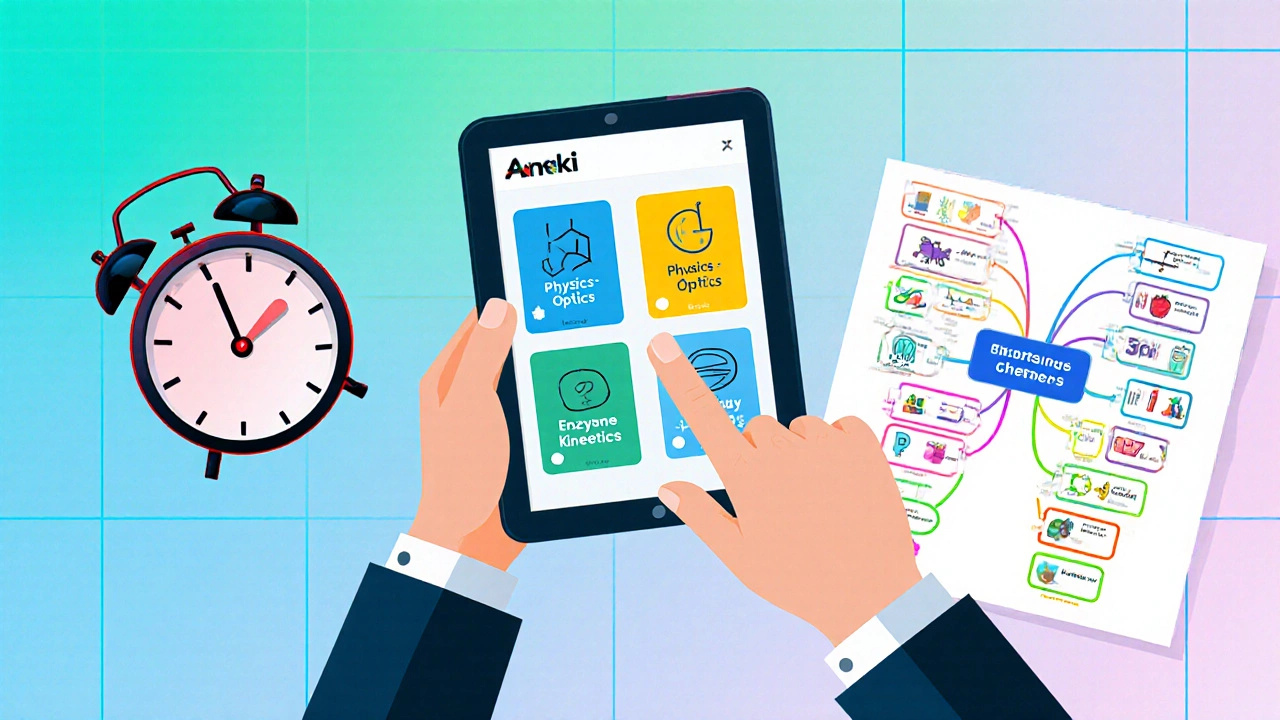When you hear NEET the National Eligibility cum Entrance Test, India’s gateway to MBBS and BDS seats, the first thing that scares many students is the sheer volume of facts to remember. You’ve probably tried reading chapters twice, scribbling notes, and maybe even cramming the night before - but the recall on exam day still feels weak. What if there was a proven, fast‑track approach that turns hours of study into solid, long‑lasting memory? Below is the quickest way to memorize NEET without burning out.
Identify the High‑Yield Zones
NEET covers Biology, Chemistry, and Physics, but not every topic carries the same weight. Start by pulling the official NEET Syllabus and highlight sections that appear in at least 70% of past papers. For example, in Biology, the “Cell Cycle & Genetics” block, in Chemistry “Organic Reaction Mechanisms”, and in Physics “Optics & Modern Physics”. By focusing on these high‑yield zones first, you cut down the material by roughly 30‑40%, giving you more time for deep processing.
Core Memory Strategies That Deliver Speed
Research from cognitive science shows that the combination of Active Recall and Spaced Repetition outperforms passive rereading by up to 45% in retention tests. Here’s how to apply them to NEET:
- Active Recall: After a 20‑minute study block, close the book and write down everything you remember. Use flashcards or blank sheets. The effort of pulling information from memory strengthens the neural pathways.
- Spaced Repetition: Review the same material after increasing intervals - 1 day, 3 days, 1 week, 2 weeks. This timing aligns with the forgetting curve and forces the brain to reconsolidate the memory.
Both techniques require discipline but are incredibly fast because they eliminate wasted time on recognition‑based study.
Boost Recall with Mnemonics and Visual Aids
Complex biochemical pathways or physics formulas become easier when you attach a vivid story or picture. Mnemonics like “CHON” for the major biological elements (Carbon, Hydrogen, Oxygen, Nitrogen) or the “PEMDAS” pattern for math can be adapted to medical facts. For visual learners, drawing quick Mind Maps links concepts like “Enzyme Kinetics → Vmax & Km → Michaelis‑Menten equation”. A sketch takes less than a minute but forces you to organize the information hierarchically, which improves recall speed by roughly 20%.

Set Up a High‑Efficiency Study Schedule
Pairing Pomodoro Technique with spaced repetition creates a rhythm that maximizes focus and rest. A typical day looks like this:
- Morning (2 hours): Choose a high‑yield topic, study for 25 minutes, then spend 5 minutes making active‑recall cards.
- Short break (10 minutes): Stretch, hydrate.
- Second session (2 hours): Use another 25‑minute block for a different subject, then review cards from the previous day (spaced repetition).
- Evening (1 hour): Quick “quiz‑storm” - attempt 10-15 practice questions from past NEET papers without looking at solutions.
This 4‑session structure uses the brain’s optimal attention span (≈25 minutes) and embeds the spaced‑review moments naturally.
Digital Tools That Supercharge the Process
While notebooks work, apps like Anki automate the spacing algorithm. Create decks for each subject, tag cards with the exam weight, and let the software schedule reviews. The free version supports image and audio, letting you attach diagrams or voice explanations - a proven boost for auditory learners.
Another handy tool is Google Keep for on‑the‑go flashcards, and Quizlet for community‑shared sets that already align with NEET topics.
Comparison of Fast Memorization Methods
| Technique | Core Principle | Setup Time | Best For | Average Retention Increase |
|---|---|---|---|---|
| Active Recall | Retrieve from memory | Low | All subjects | ≈45% |
| Spaced Repetition | Review at expanding intervals | Medium (requires schedule) | Long‑term retention | ≈40% |
| Mnemonics | Link info to vivid cues | Low‑Medium | Lists, pathways | ≈30% |
| Mind Maps | Visual hierarchy | Medium | Complex concepts | ≈25% |
| Pomodoro | Focused bursts + breaks | Low | Study stamina | ≈20% |
Common Pitfalls and How to Dodge Them
Pitfall 1: Rereading without testing. It feels productive but only reinforces recognition, not recall. Replace any reread with a quick self‑quiz.
Pitfall 2: Cramming all at once. The brain can’t encode massive chunks efficiently. Split the syllabus into bite‑size modules and apply spaced repetition.
Pitfall 3: Ignoring sleep. Memory consolidation happens during deep sleep. Aim for 7‑8 hours; a night of poor sleep can erase 30% of what you studied.
Pitfall 4: Using only one learning style. Mix visual (mind maps), auditory (recorded explanations), and kinesthetic (writing flashcards) to create multiple retrieval pathways.
Quick Checklist for a Fast NEET Memorization Routine
- ✔ Identify high‑yield topics from the official syllabus.
- ✔ Create active‑recall flashcards for each point.
- ✔ Use Anki or a similar app to set spaced‑repetition intervals.
- ✔ Apply a mnemonic or mind map to every complex list.
- ✔ Follow Pomodoro cycles: 25 min focus, 5 min break.
- ✔ Review yesterday’s cards before starting new material.
- ✔ Test yourself with past NEET questions daily.
- ✔ Sleep 7‑8 hours; avoid late‑night screens.
Frequently Asked Questions
How many hours should I study per day for NEET?
Aim for 6‑8 hours of focused study, split into 4‑5 Pomodoro sessions. Quality beats quantity, especially when you incorporate active recall.
Is Anki worth the learning curve?
Yes. Once you set up a deck, the algorithm handles spacing automatically, letting you concentrate on remembering the content rather than managing schedules.
Can I rely only on mnemonics for biology?
Mnemonics are great for lists (e.g., cranial nerves) but pair them with active recall to ensure you can apply the concepts in problem‑solving questions.
How often should I revisit a mind map?
Treat the mind map like a flashcard - review it after 1 day, then 3 days, then weekly. Updating colors or adding new links each time reinforces memory.
What’s the best way to tackle physics formulas?
Write each formula on a card, include a short derivation or a real‑life example, then test yourself using active recall. Combine that with spaced repetition for long‑term recall.
By following these fast‑track methods, you’ll move from mere recognition to true mastery, turning the massive NEET syllabus into a series of well‑wired memory blocks. Start today, keep the cycle consistent, and watch your confidence soar as the exam day approaches.
